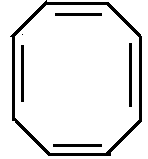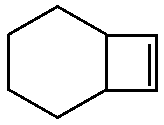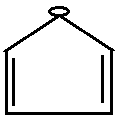
Which of the following is an antiaromatic compound?

A.
B.

C.

D.





Answer
540k+ views
Hint: We need to find the anti- aromatic compound. For solving this we use the aromaticity rule. First, the compound to be observed must be cyclic. Also, every atom in the ring must be conjugated. Then the molecule must have $ \left( {4n + 2} \right)\pi $ electrons. Anti-aromatic compounds have 4n pi electrons.
Complete step by step answer:
We will start by mentioning the aromaticity rule.
This rule is followed by aromatic and anti- aromatic compounds.
First, the compound to be observed must be cyclic. Also, every atom in the ring must be conjugated. Then the molecule must have $ \left( {4n + 2} \right)\pi $ electrons. At last, the molecule must be flat, but there are rare exceptions.
Option A is cyclooctatriene which is a non-aromatic compound. It changes to tub shaped structure.
Option B is cyclobutadiene which has $ {\text{2 \times n}}{{\text{e}}^{\text{ - }}}{\text{ where n = 2 = 4}}{{\text{e}}^{\text{ - }}} $ ,so it is antiaromatic.
Option C is not planar as the two middle C atoms are $ s{p^3} $ hybridised, thus making it non planar.
Option D is pentagon with negative charge and it is aromatic as it has $ {\text{2n}}{{\text{e}}^{\text{ - }}}{\text{ where n = 3}} $ .
Now we need to select the correct option.
Thus, the correct option is B.
Note:
Aromatic compounds are chemical compounds that consist of conjugated planar ring systems accompanied by delocalized pi-electron clouds in place of individual alternating double and single bonds. They are also called aromatics or arenes. The best examples are toluene and benzene.
Antiaromatic compounds are not necessarily unstable - they are just less stable than a bunch of ethenes connected by sigma bonds.
Another method to approach these types of questions are:
A molecule is aromatic if it is cyclic, planar, completely conjugated compound with $ 4n + 2\pi $ electrons. It is antiaromatic if all of this is correct except it has 4n electrons, any deviation from these criteria makes it non-aromatic.
Complete step by step answer:
We will start by mentioning the aromaticity rule.
This rule is followed by aromatic and anti- aromatic compounds.
First, the compound to be observed must be cyclic. Also, every atom in the ring must be conjugated. Then the molecule must have $ \left( {4n + 2} \right)\pi $ electrons. At last, the molecule must be flat, but there are rare exceptions.
Option A is cyclooctatriene which is a non-aromatic compound. It changes to tub shaped structure.
Option B is cyclobutadiene which has $ {\text{2 \times n}}{{\text{e}}^{\text{ - }}}{\text{ where n = 2 = 4}}{{\text{e}}^{\text{ - }}} $ ,so it is antiaromatic.
Option C is not planar as the two middle C atoms are $ s{p^3} $ hybridised, thus making it non planar.
Option D is pentagon with negative charge and it is aromatic as it has $ {\text{2n}}{{\text{e}}^{\text{ - }}}{\text{ where n = 3}} $ .
Now we need to select the correct option.
Thus, the correct option is B.
Note:
Aromatic compounds are chemical compounds that consist of conjugated planar ring systems accompanied by delocalized pi-electron clouds in place of individual alternating double and single bonds. They are also called aromatics or arenes. The best examples are toluene and benzene.
Antiaromatic compounds are not necessarily unstable - they are just less stable than a bunch of ethenes connected by sigma bonds.
Another method to approach these types of questions are:
A molecule is aromatic if it is cyclic, planar, completely conjugated compound with $ 4n + 2\pi $ electrons. It is antiaromatic if all of this is correct except it has 4n electrons, any deviation from these criteria makes it non-aromatic.
Recently Updated Pages
The number of solutions in x in 02pi for which sqrt class 12 maths CBSE

Write any two methods of preparation of phenol Give class 12 chemistry CBSE

Differentiate between action potential and resting class 12 biology CBSE

Two plane mirrors arranged at right angles to each class 12 physics CBSE

Which of the following molecules is are chiral A I class 12 chemistry CBSE

Name different types of neurons and give one function class 12 biology CBSE

Trending doubts
One Metric ton is equal to kg A 10000 B 1000 C 100 class 11 physics CBSE

Explain zero factorial class 11 maths CBSE

What is 1s 2s 2p 3s 3p class 11 chemistry CBSE

Discuss the various forms of bacteria class 11 biology CBSE

State the laws of reflection of light

An example of chemosynthetic bacteria is A E coli B class 11 biology CBSE




